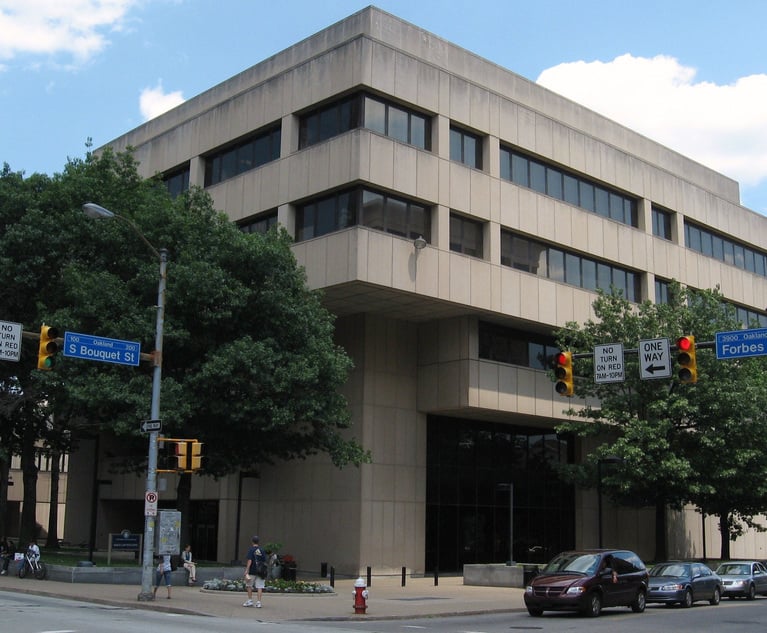Fintech 2020 and Beyond: The Decade of Regulatory Collaboration
The past two decades have seen rapid expansion and exponential growth of financial services technology (fintech) and financial services innovation.
February 07, 2020 at 12:36 PM
6 minute read
 Joann Needleman of Clark Hill.
Joann Needleman of Clark Hill.
The past two decades have seen rapid expansion and exponential growth of financial services technology (fintech) and financial services innovation. For example, financial transactions from the depositing of a simple check to applying for a mortgage can be accomplished electronically and more importantly, in the palm of your hand on a cellphone.
In 2008, while bank and nonbank institution fintech and innovation were flourishing, this country encountered a significant financial downturn that disrupted the financial services industry. The United States responded in the 2010s by entering into a period of intense regulation of financial services. For example, Dodd-Frank reorganized the financial regulatory system, eliminated agencies like the Office of Thrift Supervision, assigned new responsibilities to existing agencies, and created new agencies like the Consumer Financial Protection Bureau (CFPB). While this new regulatory scheme was instrumental in bringing stability into the country's economy, the framework at times is rigid and did not allow or anticipate innovation to evolve in an orderly and sustainable basis.
Fast forward to February 2017, when the current administration issued a series of executive orders directed at several federal agencies, including the Treasury. The executive orders directed the agencies to do a top-to bottom assessment of the financial services regulatory system. The executive orders also required agencies to issue reports. In July 2018, the Treasury Department issued its mandated report titled, "A Financial System That Creates Economic Opportunities: Nonbank Financials, Fintech, and Innovation." The report recommends that federal agencies, among other things, streamline the regulatory environment to foster innovation across business models, modernize activity and specific regulations and facilitate experimentation.
Based upon these recommendations, federal agencies spent the last two years developing policies and frameworks for regulatory engagement with not only a more welcoming approach, but with the goal of responsible innovation. Taking a page from the Financial Conduct Authority (FCA) in Britain, U.S. regulators are looking to develop "sandboxes." The sandboxes allow innovators to test financial products and services in controlled environments with reduced regulatory scrutiny provided there is information sharing, alternative licensing and charter arrangements, and the explanation of already-existing no action policies. Below are four agencies which are opening the door for regulatory engagement.
CFPB
As mandated by Dodd-Frank, one of the many objectives of the CFPB is to ensure that markets for consumer financial products and services operate transparently and efficiently to facilitate access and innovation. CFPB's project catalyst was developed as an initiative designed to encourage consumer-friendly developments in markets for consumer financial products and services. To facilitate that partnership, the bureau offered a "no action letter." A no action letter is a statement from the agency that allows financial innovators to market products and services without fear of enforcement. However, the no action letters were nonenforceable and nontransferrable, and they could be revoked at any time. Under project catalyst only one no action letter was issued.
During his tenure as the acting director of the CFPB, Mick Mulvaney established the Office of Innovation (OOI) in 2018, which took a different approach. In September 2019, under new Director Kathleen Kraninger, the CFPB set forth formal policies and a specific application process for entities to partner and collaborate with the CFPB. The no action letter policy was revived "in order to increase participation by companies seeking to advance new products and services." Additionally, the CFPB re-instituted the trial disclosure program that was mostly dormant under the prior CFPB administration. Finally, the CFPB established a "compliance assistance sandbox," which provides approved applicants a safe harbor for testing innovative products and services for a limited period of time while sharing data with the CFPB. In the consumer financial services, there is interest in these opportunities and is the CFPB expects that many start-ups as well as established entities will be speaking with the CPFB in the coming year and beyond.
The Office of Comptroller of Currency (OCC)
The OCC has also set up an Office of Innovation with the goal of supporting responsible innovation. Last April the agency sought public comment on a proposed innovation pilot program (the program). The OCC looks to partner with financial institutions in order to "foster constructive innovative ideas to improve the industry." In a public statement, the OCC outlined the program's goals to support innovation in the banking system; foster communication between the OCC and entities regarding expectations and requirements; further understand innovative activities and how to properly maintain them; and (4) promote the OCC's objectives. Ideally, these goals would be achieved by creating a transparent framework for entities to engage with the OCC to test potential innovative products on a small scale and short term period. The program is open only to OCC-supervised financial institutions. However, third parties working with a financial institution may become eligible to participate in the program. A final policy is expected shortly.
Security and Exchange Commission (SEC)
In July 2018, the SEC launched FinHub, a website devoted to facilitating the SEC's public engagement with innovators, developers and entrepreneurs. Particular areas of interest are blockchain/distributed ledgers, digital marketplace financing, automated investment advice and artificial intelligence (AI) and machine learning. The website provides pertinent regulations, investor information, opportunities for comment and empirical data. SEC Chairman Jay Clayton is quoted as saying, "the SEC is committed to working with investors and market participants on new approaches to capital formation, market structure, and financial services, with an eye toward enhancing, and in no way reducing, investor protection."
Federal Deposit Insurance Co. (FDIC)
In July 2019, FDIC Chairman Jelena McWilliams, announced the formation within the FDIC of the FDIC tech lab or FDiTech. This new entity will promote the adoption of innovative and transformative technologies in the financial services sector, help FDIC better understand how innovation can contribute to the expansion of banking services, and promote the adoption of technology that can help community banks compete in the modern financial marketplace. The goals of FDiTech encompass engagement and collaboration with innovators in the financial and non-financial sectors to identify, develop and promote technology-driven solutions.
Engaging with financial regulators requires a well-thought out strategy with well-defined objectives that will require concessions from each party. For regulators, the relaxing of regulatory expectations will have its limits. For financial institutions and fintech entities it will mean sticking your head out of the proverbial foxhole in order to advance state-of-the art ideas to retain and welcome new customers. It will be a delicate balance, but now more than ever, regulators want to invite the financial services industry to join in the conversation.
Joann Needleman, a member at Clark Hill, is the leader of the firm's consumer financial services regulatory and compliance practice group, serves as a navigator to her clients seeking advice and guidance in the complex regulatory environment facing the financial services industry. Contact her at [email protected].
This content has been archived. It is available through our partners, LexisNexis® and Bloomberg Law.
To view this content, please continue to their sites.
Not a Lexis Subscriber?
Subscribe Now
Not a Bloomberg Law Subscriber?
Subscribe Now
NOT FOR REPRINT
© 2025 ALM Global, LLC, All Rights Reserved. Request academic re-use from www.copyright.com. All other uses, submit a request to [email protected]. For more information visit Asset & Logo Licensing.
You Might Like
View All
Law Firms Look to Gen Z for AI Skills, as 'Data Becomes the Oil of Legal'

De-Mystifying the Ethics of the Attorney Transition Process, Part 2

Pennsylvania Law Schools Are Seeing Double-Digit Boosts in 2025 Applications
5 minute readLaw Firms Mentioned
Trending Stories
Who Got The Work
J. Brugh Lower of Gibbons has entered an appearance for industrial equipment supplier Devco Corporation in a pending trademark infringement lawsuit. The suit, accusing the defendant of selling knock-off Graco products, was filed Dec. 18 in New Jersey District Court by Rivkin Radler on behalf of Graco Inc. and Graco Minnesota. The case, assigned to U.S. District Judge Zahid N. Quraishi, is 3:24-cv-11294, Graco Inc. et al v. Devco Corporation.
Who Got The Work
Rebecca Maller-Stein and Kent A. Yalowitz of Arnold & Porter Kaye Scholer have entered their appearances for Hanaco Venture Capital and its executives, Lior Prosor and David Frankel, in a pending securities lawsuit. The action, filed on Dec. 24 in New York Southern District Court by Zell, Aron & Co. on behalf of Goldeneye Advisors, accuses the defendants of negligently and fraudulently managing the plaintiff's $1 million investment. The case, assigned to U.S. District Judge Vernon S. Broderick, is 1:24-cv-09918, Goldeneye Advisors, LLC v. Hanaco Venture Capital, Ltd. et al.
Who Got The Work
Attorneys from A&O Shearman has stepped in as defense counsel for Toronto-Dominion Bank and other defendants in a pending securities class action. The suit, filed Dec. 11 in New York Southern District Court by Bleichmar Fonti & Auld, accuses the defendants of concealing the bank's 'pervasive' deficiencies in regards to its compliance with the Bank Secrecy Act and the quality of its anti-money laundering controls. The case, assigned to U.S. District Judge Arun Subramanian, is 1:24-cv-09445, Gonzalez v. The Toronto-Dominion Bank et al.
Who Got The Work
Crown Castle International, a Pennsylvania company providing shared communications infrastructure, has turned to Luke D. Wolf of Gordon Rees Scully Mansukhani to fend off a pending breach-of-contract lawsuit. The court action, filed Nov. 25 in Michigan Eastern District Court by Hooper Hathaway PC on behalf of The Town Residences LLC, accuses Crown Castle of failing to transfer approximately $30,000 in utility payments from T-Mobile in breach of a roof-top lease and assignment agreement. The case, assigned to U.S. District Judge Susan K. Declercq, is 2:24-cv-13131, The Town Residences LLC v. T-Mobile US, Inc. et al.
Who Got The Work
Wilfred P. Coronato and Daniel M. Schwartz of McCarter & English have stepped in as defense counsel to Electrolux Home Products Inc. in a pending product liability lawsuit. The court action, filed Nov. 26 in New York Eastern District Court by Poulos Lopiccolo PC and Nagel Rice LLP on behalf of David Stern, alleges that the defendant's refrigerators’ drawers and shelving repeatedly break and fall apart within months after purchase. The case, assigned to U.S. District Judge Joan M. Azrack, is 2:24-cv-08204, Stern v. Electrolux Home Products, Inc.
Featured Firms
Law Offices of Gary Martin Hays & Associates, P.C.
(470) 294-1674
Law Offices of Mark E. Salomone
(857) 444-6468
Smith & Hassler
(713) 739-1250






